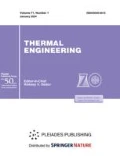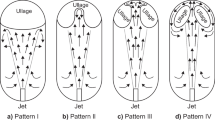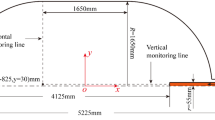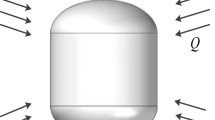Abstract
The basic results of space tests of liquid droplet cooler-radiator models as the main elements of frameless systems for low-grade heat rejection are considered. The studies carried out have been analyzed and intermediate elaboration’s results are summarized, which concern (1) the development of generators of droplet propellant flows, (2) revealing an operational behavior of fluid collectors of various types and analysis of unsolved problems associated with droplet collection upon the open trajectory’s section passage, and (3) provision of the coolant circulation contour’s closing. The necessity is substantiated for the activization of works directed to carrying out space experiments with improved radiator models and new promising propellants in order to provide a possibility of creating new space power plants characterized by megawatt power levels.
Similar content being viewed by others
References
E. P. Volkov, V. S. Vysotskii, A. V. Karpyshev, et al., Production of first in Russia high-temperature superconducting cable, Izv. Ross. Akad. Nauk, Energ., No. 4, 31–43 (2009).
E. P. Volkov and E. A. Dzhafarov, “Superconducting transformer with rotating magnetic field,” Izv. Ross. Akad. Nauk, Energ., No. 3, 113–121 (2012).
E. P. Volkov and E. A. Dzhafarov, “HTSC transformer with localized magnetic field,” Izv. Ross. Akad. Nauk, Energ., No. 5, 3–10 (2013).
Sh. I. Lutidze and E. A. Dzhafarov, Superconducting Transformers (Nauchtekhlitizdat, Moscow, 2002) [in Russian].
K. Hiroki, K. Masashi, K. Toyoaki, et al., “Current limiting and recovery characteristics of 2MVA class superconducting fault current limiting transformer,” IEEE Trans. Appl. Supercond., 21, 1401–1404 (2011).
G. Wojtasiewicz, T. Janowski, S. Kozak, et al., “Experimental investigation of the model of superconducting transformer with the winding made of 2G HTS tape,” IEEE Trans Appl. Supercond., 22, 5500604 (2012).
D. Shaotao, X. Liye, W. Zikai, et al., “Development and demonstration of 1 MJ High-Tc SMES,” IEEE Trans. Appl. Supercond., 22, 5700304 (2012).
M. Staines, P. Mohinder, M. J. Long, et al., The Development of a Roebel Cable Based 1 MVA HTS Transformer, Industrial Research Limited (New Zealand), (2011).
Y. Wang, X. Zhao, J. Han, etal., “Development and test in grid of 630 kVA three-phase high temperature superconducting transformer,” Front. Elektr. Electron. Eng. China, 4, 104–113 (2009).
E. P. Volkov and E. A. Dzhafarov, RF Patent No. 2516291, Byull. Izobr., No. 14 (2014).
G. N. Petrov, Electrical Machines (Energiya, Moscow, 1974) [in Russian].
M. P. Kostenko and L. M. Piotrovskii, Electrical Machines (Energiya, Moscow, 1964) [in Russian].
S. B. Vasyutinskii, Questions of Theory and Calculation of Transformers (Energiya, Leningrad, 1970) [in Russian].
L. A. Dissado and J. C. Fothergill, Electrical Degradation and Breakdown in Polymers (Peter Peregrinus, London, 1992).
S. Kitai, S. Asai, and K. Hirotsu, “Long-term ageing phenomena in XLPE cables,” in Proc. 2nd Int. Conf. on Polymer Insulated Power Cables–Jicable’87, Versailles, France, 1987 A 9.4, pp. 446–450.
T. Fukuda and Z. Iwata, “Progress in technology for HV cables, insulated with XLPE,” Furukawa Electric Rev., No. 5, 1–18 (1987).
K. Kaminaga and N. Yoshifuji, et al., “Study on degradation mechanism of XLPE cables,” in Proc. 4nd Int. Conf. on Polymer Insulated Power Cables–Jicable’95, Versailles, France, 1995 A 8.4, pp. 215–220.
N. Hozumi, T. Okamoto, and H. Fukagawa, “Simultaneous measurement of microscopic image and discharge pulses at the moment of electrical tree initiation,” Japan. J. Appl. Phys. 27, 572–576 (1988).
Methods of Test for Evaluating the Resistance of Insulating Materials against the Initiation of Electrical Trees IEC Technical Report 1072 (1991).
M. Yu. Shuvalov, M. A. Mavrin, V. L. Ovsienko, and A. V. Romashkin, “Videomicroscopy of electrical and water triings,” Elektrichestvo, No. 7, 68–76 (1997).
V. L. Ovsienko, M. Yu. Shuvalov, D. V. Koloskov, and A. V. Romashkin, “Possibilities of experiment in the study of electrical isolation of high-tension cables,” Kabel’naya Tekhnika, Nos. 10–11, 47–57 (1997).
M. Yu. Shuvalov, Y. V. Obraztsov, V. L. Ovsienko, A. Kruchkov, and P. Huotari, “The study of on-line relaxation effect on internal mechanical stresses and dielectric strength of HV cable insulation,” in Proc. 5th Int. Conf. on Insulated Power Cables–Jicable-99, Versailles, France, 1999, C 6.5, pp. 798–804.
V. L. Ovsienko, M. Yu. Shuvalov, M. I. Shashakov, and A. M. Khokhlov, RF Patent No. 2137104, Byull. Izobr., 1999, No. 25, Part 3, p. 504.
N. Shimizu and C. Laurent, “Electrical tree initiation,” IEEE Trans. Dielectr. Electr. Insul. 5, 651–659 (1998).
G. C. Montanari, “Electrical life threshold models for solid insulated materials subjected to electrical and multiple stresses. Investigation and comparison of life models,” IEEE Trans. Electr. Insul. 27, 974–986 (1992).
L. Simoni, G. Mazzanti, and G. C. Montanari, “General multi-stress life model for insulating materials with or without evidence for thresholds,” IEEE Trans. Electr. Insul. 28, 349–364 (1993).
T. Tanaka and A. Greenwood, “Effects of charge injection and extraction on tree initiation in polyethylene,” IEEE Trans. Power Apparat. Syst. 97, 1749–1759 (1978).
M. Yu. Shuvalov, “Study of high power cables, development of improved methods of electrical calculation and diagnostics,” Doctoral (Eng.) Dissertation (VNIIKP, Moscow, 2000)
M. Yu. Shuvalov, “Initiation of electrical triing as the process of development of micronidal explosive unstability,” Elektrotekhnika, No. 12, 12–20 (1997).
Y. V. Obraztsov and M. Y. Shuvalov, “Model for highvoltage extruded cable insulation ageing: Electrical tree inception as explosive instability development,” in Proc. Int. Conf. on Large High Voltage Electric Systems (CIGRE (in French: Conseil International des Grands Réseaux Électriques)), Paris, 1998, Nos. 15-204, (1998).
I. B. Peshkov and M. Yu. Shuvalov, “New approach to estimation of power high-tension cable resource,” Izv. AN SSSR. Energ. Transp., No. 4, 23–34 (1991).
E. T. Larina and M. Yu. Shuvalov, “Electrical ageing and electrical triing of cable isolation,” in Study and Production of Cables and Wires. Coll. Sci. Papers, No. 31, (Moscow, 1991), pp. 21–42 [in Russian].
M. Yu. Shuvalov, “Elements of design of high-tension cables with plastic isolation,” Kabel’naya Tekhnika, No. 5, 25–29 (1994).
S. Nagasaki, N. Yoshida, and M. Aihara, “Philosophy of design and experience on high voltage XLPE cables and accessories in Japan,” in Proc. Int. Conf. on Large High Voltage Electric Systems (CIGRE (in French: Conseil International des Grands Réseaux Électriques)), Paris, 1998, Nos. 21-01 (1988).
T. Kubota, Y. Takahashi, S. Sakuma, et al., “Development of 500 kV XLPE cables and accessories for long distance underground transmission line?Part I: Insulation design of cables,” WM 097-6PWRD. Publication ETR No. 3A-2038, IEEE (1944).
H. Tanaka, T. Tanaka, H. Noda, et al., “Technical progress of HV XLPE insulated power cable (Part 3)? Development of the 500 kV XLPE cable and joint for long distance transmission line,” Furukawa Rev., No. 15, 19–29 (1996).
E. T. Larina, Power Cables and High Voltage Cable Lines (Energoatomizdat, Moscow, 1996) [in Russian].
N. V. Bondareva, L. M. Glukhov, A. A. Koroteev, V. G. Krasovskii, L. M. Kustov, Yu. A. Nagel’, A. A. Safronov, N. I. Filatov, and E. A. Chernikova, “Frameless systems of low-potential heat removing in cosmos: Successes of workings off and unsolved problems,” Izv. Ross. Akad. Nauk, Energ., No. 4, (2015) (in press).
G. V. Konyukhov, A. A. Koroteev, and V. P. Poluektov, “Study of working process in tiny refrigerator-radiator at microgravitation and deep vacuum,” Polet, No. 4, 26–32 (2001).
“Study of hydrodynamics and heat transfer of monodispersed tiny flows at microgravitation,” Express report on cosmic experiment, cypher “Kaplya-2”, No. 051-12/19-14, GNTs FGUP “Tsentr Keldysha”, OAO RKK “Energiya” im. S.P. Koroleva, 2014.
L. A. Donskoi, V. P. Pylev, B. A. Rabinovich, and V. V. Sergeev, “Study of parameters of rarefied atmosphere surrounding the space vehicles during orbital flight,” Aviakosm. Priborostr., No. 6, (2003).
B. V. Gnedenko, Probability Theory Course (GITTL, Moscow, 1954) [in Russian].
S. N. Buravova, S. M. Gavrilkin, and Yu. A. Gordopolov, “Dynamic fatigue,” Tech. Phys. 50, 1038–1042 (2005).
V. K. Kedrinskii, V. V. Kovalev, and S. I. Plaksin, “On one model of bubble cavitation in real liquid,” Prikl. Mekh. Tekh. Fiz. 27, 81–85 (1986).
M. A. Askarov, “Study of relative cavitation durability of some metals and alloys,” Akust. Zh. 22, 326–331 (1976).
V. V. Pilipenko, Cavitation Autooscillations (Naukova Dumka, Kiev, 1989) [in Russian].
V. E. Nakoryakov, B. G. Pokusaev, and I. R. Shreiber, Wave Dynamics of Gasand Vapor-Liquid Media (Energoatomizdat, Moscow, 1990) [in Russian].
I. V. Anan’ev, Handbook for Calculation of Self-Oscillations of Elastic Systems (OGIZ GITTL, Moscow, 1946) [in Russian].
D. V. Sivukhin, General Course of Physics. Vol. 1. Mechanics (Nauka, Moscow, 1989) [in Russian].
Author information
Authors and Affiliations
Corresponding author
Additional information
Original Russian Text © A.A. Koroteev, Yu.A. Nagel, N.I. Filatov, 2015, published in Izvestiya Rossiiskoi Akademii Nauk. Energetika.
Rights and permissions
About this article
Cite this article
Koroteev, A.A., Nagel, Y.A. & Filatov, N.I. Experimental elaboration of liquid droplet cooler-radiator models under microgravity and deep vacuum conditions. Therm. Eng. 62, 965–970 (2015). https://doi.org/10.1134/S0040601515130066
Received:
Published:
Issue Date:
DOI: https://doi.org/10.1134/S0040601515130066




